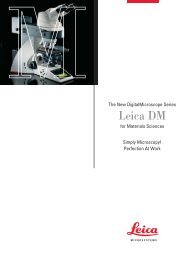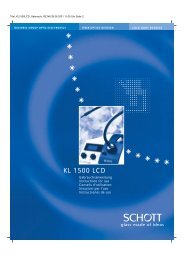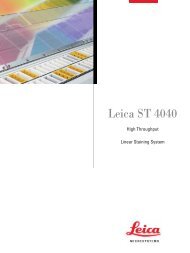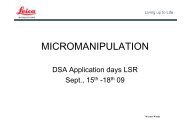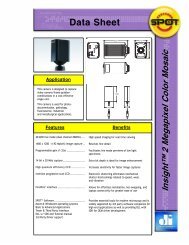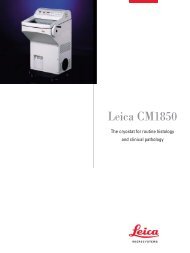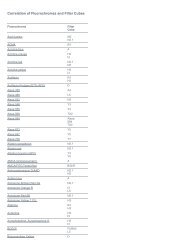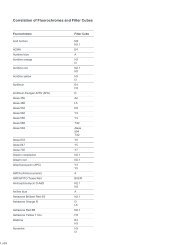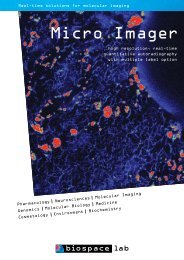Leica Z16 APO A Brochure - Meyer Instruments, Inc.
Leica Z16 APO A Brochure - Meyer Instruments, Inc.
Leica Z16 APO A Brochure - Meyer Instruments, Inc.
You also want an ePaper? Increase the reach of your titles
YUMPU automatically turns print PDFs into web optimized ePapers that Google loves.
Automatically productive<br />
<strong>Leica</strong> Z6 <strong>APO</strong> A and <strong>Leica</strong> <strong>Z16</strong> <strong>APO</strong> A. Motorized zoom systems for<br />
documentation, inspection and machine vision
When the human eye is no longer sufficient, optical zoom systems extend the resolution. In the<br />
macro range, the new zoom systems <strong>Leica</strong> Z6 <strong>APO</strong> A and <strong>Z16</strong> <strong>APO</strong> A allow for a quick inspection of<br />
complete objects – for example, an electronic circuit, a workpiece manufactured by a machine or<br />
an undisturbed biological specimen. The overview of a large section offers valuable context and<br />
relationship information. You can continuously increase the magnification of selected details for<br />
closer inspection. Here, it is not the amount of the magnification level alone which determines the<br />
quality of the information, but also the performance of the zoom optics with regard to resolution,<br />
contrast, image sharpness, image fidelity and color fidelity.<br />
Excellent optics for numerous applications<br />
The zoom systems <strong>Leica</strong> Z6 <strong>APO</strong> A and <strong>Z16</strong> <strong>APO</strong> A correspond to the highest quality standards<br />
worldwide and meet all requirements for first-class documentation, manufacture and inspection.<br />
The fully apochromatic optics made of high-quality, multiple-coated, lead-free glasses, in combina-<br />
recision<br />
tion with the planapochromatic objectives provide parallax-free imaging for authentic, detail-rich<br />
image material. But the two zoom systems are not only exceptional with respect to the optics, they<br />
also excel with respect to operating comfort at the highest level.<br />
2<br />
Highest precision! Now with even<br />
more comfort and speed<br />
Quality control of fiber-optics waveguide M12 mounting connector for industrial applications<br />
Comfortable motorization for quick and safe application<br />
In both systems, zoom, iris diaphragm and fine focus are motorized. This allows for automating<br />
inspection and documentation tasks in the future. For many applications, this proves to be extremely<br />
time-saving and useful, images can automatically be calibrated and inserted in a database.<br />
Reference scales, such as measurement graticules or µ-beams, can be inserted directly in the<br />
image. Using the PC control system, sequential recordings can be repeated under different conditions<br />
without any manual intervention, and test positions can be approached with highest precision<br />
using the optional motor focus, thereby increasing productivity multiple times.<br />
With <strong>Leica</strong> Z6 <strong>APO</strong> A & <strong>Z16</strong> <strong>APO</strong> A – automated toward 100% quality
Flexible circuit board<br />
<strong>Leica</strong> <strong>Z16</strong> <strong>APO</strong> A zoom system on<br />
incident-light base with motor focus,<br />
<strong>Leica</strong> HD V video/photo tube,<br />
<strong>Leica</strong> DFC digital camera and<br />
<strong>Leica</strong> UMC manual control
Highlights of <strong>Leica</strong> Z6 <strong>APO</strong> A<br />
and <strong>Leica</strong> <strong>Z16</strong> <strong>APO</strong> A<br />
Objectives: planapochromatic, achromatic,<br />
HR and DM objectives for high<br />
magnifications<br />
Coaxial incident light housing for<br />
fiber-optic light<br />
Foot switch for control of motorized functions<br />
Extension plate for reproduction stands<br />
<strong>Leica</strong> HD V and HD F video/photo tubes with<br />
beam splitter 0:100 or 50:50<br />
4<br />
Apochromatic ErgoTube ® with 10°– 50° viewing<br />
angle for relaxed head position<br />
• Synchronous adjustment of interpupillary<br />
distance from 55 mm to 75 mm<br />
<strong>Leica</strong> HD F and HD V video/photo tubes<br />
• HD F beam splitter visual/photo 50:50<br />
• HD V beam splitter visual/photo 0:100, 50:50<br />
• Ideal in conjunction with ErgoTube ® and<br />
<strong>Leica</strong> digital camera<br />
<strong>Leica</strong> <strong>Z16</strong> <strong>APO</strong> A<br />
Zoom 16:1, zoom range 0.57× – 9.2×<br />
• Magnification 7.1× – 115×, visual<br />
• Total magnification 920×, visual<br />
• Resolution 336 Lp/mm<br />
up to 672 Lp/mm<br />
• Numeric aperture 0.112<br />
up to 0.224<br />
Motorized functions<br />
• Continuous positioning zoom<br />
for repetitive tasks<br />
• Built-in iris diaphragm for depth of field<br />
adjustment<br />
• Integrated fine focus for precise<br />
focusing<br />
• Can be operated with PC, <strong>Leica</strong> UMC<br />
manual control and/or foot switch<br />
• Motor focus available as option<br />
Fully apochromatic zoom system<br />
• Apochromatic objectives for superlative<br />
contrast, color fidelity and detail richness<br />
• Highest image fidelity for precise<br />
measurements, analysis and documentation<br />
• True color polarization for polarized optical<br />
examinations<br />
High-performance HL RC TM transmitted-light base<br />
for best relief contrast<br />
• Direct transmitted light<br />
• Oblique to dark-field similar transmitted light<br />
for low in contrast semitransparent objects<br />
• Illumination with optical waveguide<br />
• Variants: heating stages, polarizer,<br />
gliding stage, swing arm stands
<strong>Leica</strong> Design by<br />
Christophe Apothéloz<br />
<strong>Leica</strong> digital camera<br />
• High-resolution <strong>Leica</strong> camera lines<br />
for many and diverse demands<br />
• Modular image editing and analysis software<br />
<strong>Leica</strong> Image Manager, QWin<br />
and Materials Workstation<br />
Ergonomics and variability<br />
• Y-tube for binocular tubes, ErgoModule ®<br />
and accessories from the <strong>Leica</strong> product range<br />
• A-tube for direct connection of<br />
C-mount adapter for <strong>Leica</strong> digital<br />
cameras<br />
Different microscope carriers<br />
• For Y and A-tube and accessories from<br />
the <strong>Leica</strong> product range<br />
• Can be mounted in 2 positions, high/low<br />
• Optics carrier can be rotated 360°<br />
Focusing drive with easy to reach handgrips<br />
• Individually adjustable torque for effortless<br />
focusing<br />
• Precise movements in the optical axis,<br />
the image remains centered<br />
• Variant: tiltable focusing arm for<br />
swing arm stand<br />
M12 8-pole mounting coupling, shielded<br />
• Power supply<br />
• RS232 interface for control<br />
<strong>Leica</strong> Z6 <strong>APO</strong> A<br />
Zoom 6:1, zoom range 0.57× – 3.6×<br />
• Magnification 7.1× – 45×, visual<br />
• Total magnification 360×, visual<br />
• Resolution 351 Lp/mm, visual<br />
up to 702 Lp/mm<br />
• Numeric aperture 0.117, visual up to 0.234<br />
Metal back plate<br />
• Rugged design for assembly with OEM<br />
applications or assembly of adapters<br />
Working distance, multi-focus, illumination<br />
• Large working distance 97 mm* –<br />
187 mm**<br />
• Perfect for multifocus applications in<br />
various specimen planes<br />
• Smooth, distortion-free images of flat<br />
reflective objects for coaxial illumination<br />
Digital high-performance cameras from the<br />
<strong>Leica</strong> DFC camera line<br />
Archiving and image editing software<br />
<strong>Leica</strong> Image Manager<br />
Image analysis software <strong>Leica</strong> QWin<br />
M12 mounting connector for individual use in<br />
automatic production devices<br />
Wide selection of ergonomic<br />
accessories<br />
5
Fully automatic from now on: Inspection of large carrier materials<br />
The production of TFT or plasma screens experiences a trend towards larger carrier<br />
materials. For this reason, a continuous inspection using stereomicroscopes<br />
is<br />
uality<br />
no longer possible. Instead, the new <strong>Leica</strong> Z6 <strong>APO</strong> A or <strong>Z16</strong> <strong>APO</strong> A zoom systems<br />
are ideal for the inspection devices being used. In this case, the operator uses a<br />
high-precision XY drive to approach a random number of positions that are subsequently<br />
inspected for structural flaws using the high-performance optics of the<br />
<strong>Leica</strong> zoom system. Every position is automatically checked at two different magnifications<br />
that are preprogrammed and then automatically approached with the<br />
6<br />
100% quality – 100% safety<br />
Fit for zero-defect production<br />
In every area of industry, quality objectives are continually reaching new levels; at<br />
the same time, the demands on throughput and productivity are increasing. For this<br />
reason, more and more companies demand DPM (defects per million) of less than<br />
100 from their suppliers. All world-class companies must even pursue a zero<br />
defects production.<br />
One important component in this endeavor is the quality control accompanying the<br />
process. It allows for detecting tolerance deviations and their causes as early as<br />
possible in the production process and removing them. This is the only way to<br />
avoid sustained follow-up costs from rejects, downtimes, warranty, image loss,<br />
etc.<br />
Higher precision, improved productivity and the resulting higher profits ultimately<br />
mean securing the future of the company and the participation in international<br />
competition.<br />
motorized zoom. This method can be applied with all inspection machines for<br />
microstructures, such as printed circuit boards.<br />
High performance – high safety<br />
With the <strong>Leica</strong> Z6 <strong>APO</strong> A and the <strong>Z16</strong> <strong>APO</strong> A, you are using the only motorized, fully<br />
apochromatically corrected zoom systems on the market. Combined with apochromatic<br />
objectives, these instruments are far superior to other zoom systems with<br />
respect to contrast, image sharpness, color fidelity and imaging accuracy. Every<br />
defect can be detected safely, quickly, and reliably. This gives you the security of<br />
an efficient, troublefree, 100% quality control, together with the ruggedness of an<br />
inspection system that operates with permanent precision even in a severe industrial<br />
environment.<br />
From individual measurement and inspection stations to system integration<br />
What is more, <strong>Leica</strong> offers components for individual measurement and inspection<br />
stations tailored to the needs of customers. The <strong>Leica</strong> zoom systems feature the<br />
largest accessory program on the market and can be combined for all applications<br />
in examination, training and documentation tasks.<br />
We are thankful to TRIDONICATCO<br />
Dornbirn/Austria for providing support<br />
in form of application images and<br />
information
Large application options for<br />
smallest parts<br />
Perfect for the manufacture of micromechanical parts<br />
Thanks to new manufacturing engineering, it is possible to manufacture increasingly<br />
smaller mechanical parts. Assembly preparations and the assembly itself are,<br />
therefore,very complex. They can no longer be carried out with the naked eye. The<br />
new <strong>Leica</strong> Z6 <strong>APO</strong> A and <strong>Leica</strong> <strong>Z16</strong> <strong>APO</strong> A zoom systems facilitate, accelerate and<br />
improve this process many times over:<br />
Thanks to the excellent optics, the position and orientation of tiniest parts (up to<br />
1.4 µm) can be detected with precision. In addition, the apochromatic optics prevents<br />
any distortion and colored edges. This is particularly important since it is the<br />
only way to reliably achieve the highest possible manufacturing quality.<br />
Excellent acutance of the finest structures<br />
Simple optic systems provide an imprecise image, because not all spectral colors<br />
are rendered uniformly and bothersome color seams result. The <strong>Leica</strong> Z6 <strong>APO</strong> A<br />
and <strong>Z16</strong> <strong>APO</strong> A apochromatic zoom systems, on the other hand, are perfectly chromatically<br />
corrected and provide sharp, detail-rich, true-color pictures.<br />
<strong>Leica</strong> Z6 <strong>APO</strong> A – highest magnifications, highest numerical aperture<br />
optics<br />
The higher the numerical aperture, the better the resolution. Compared to other<br />
zoom systems, the <strong>Leica</strong> Z6 <strong>APO</strong> A with 6.3:1 zoom offers the highest numerical<br />
aperture: 0.117 nA (resolution of 351 Lp/mm) with the 1× planapochromatic objective<br />
and 234 nA (resolution of 702 Lp/mm) with the 2× planapochromatic objective.<br />
Details of the specimen appear in higher resolution, and the quantity and quality of<br />
information are increased. Because of its very high resolution, the <strong>Leica</strong> Z6 <strong>APO</strong> A<br />
is exceptionally well suited to industrial, scientific and medical applications. The<br />
<strong>Leica</strong> Z6 <strong>APO</strong> A is slim and compact and lends itself as a high-performance optical<br />
system for measuring and testing equipment, up to "seeing systems."<br />
7
Pitting in detail
Economic solutions for macrodocumentation<br />
Complete documentation solutions are indispensable to more efficiency and higher throughput in laboratories. The <strong>Leica</strong> Z6 <strong>APO</strong> A<br />
and the <strong>Z16</strong> <strong>APO</strong> A provide powerful prerequisites for this purpose. These zoom systems first macroscopically document the object to<br />
be inspected. The resulting images are automatically entered in the image database – such as the <strong>Leica</strong> IM1000. In the process, the<br />
motorized zoom automatically reports the magnification used to the software; hence, the scale is directly acquired and can be inserted<br />
in the image. The instrument is operated via foot switch so that the hands can be used freely. This process can also be applied in<br />
forensics, pathology, and in industrial laboratories – upon request also with the <strong>Leica</strong> UMC manual control. For the user in the lab and<br />
in research, this translates to significant time saved in processing as well as more precise data for analyses and documentation.<br />
Reliable test setups for high-tech developments<br />
No new high-tech developments without high-performance optics: Only through the observation of highly dynamic processes is it possible<br />
to gain precise analyses and information for possible improvements. For this purpose, the <strong>Leica</strong> zoom systems are combined with<br />
a high-speed camera and the test setup is illuminated by a strobe for the recording. Thanks to the motorization of the <strong>Leica</strong> Z6 <strong>APO</strong> A<br />
or <strong>Leica</strong> <strong>Z16</strong> <strong>APO</strong> A, the test arrangement can easily be changed and different states can sequentially be recorded without any manual<br />
intervention. Even more convenience is provided by the serial interface of the zoom. It leads to the distribution box which allows for<br />
direct connection of the foot switch, the <strong>Leica</strong> UMC manual control and the PC.<br />
results<br />
This allows for total magnifications of up to 460× and a resolution of up to 1350 Lp/mm. With the standard configuration (apochromatic<br />
Transmitted-light base HL RC<br />
Results and analyses<br />
including time saved<br />
TFT panel Wafer<br />
Metal plate for universal assembly<br />
<strong>Leica</strong> <strong>Z16</strong> <strong>APO</strong> A – highest magnifications, ultra-sharp images<br />
The <strong>Leica</strong> <strong>Z16</strong> <strong>APO</strong> A offers a 16:1 zoom with a zoom range from 0.57× to 9.2×, which is also effective for use with the HR objectives.<br />
1× objective and 10× eyepieces) objects can be observed at a magnification level of up to 115x and, depending on the optics combination,<br />
to a maximum of 920x. You can zoom continuously from an overview to a detail view, but can also save 13 precise click-stop zoom<br />
positions for tasks such as repetitive measurements and photographs. The high resolution, the parallax-free images made possible by<br />
the vertical beam path as well as the accessories for adapting high-magnification microscope objectives, for measurements, polarization,<br />
digital and video documentation satisfy the highest demands for an optical system.<br />
Wafer with incident illumination<br />
9
From macro to micro<br />
In order to maintain 100% quality control, customers entrusted with industrial quality surveillance, as well as Original Equipment<br />
Manufacturers, mechanical engineers and automation technicians, expect top performance and flexible construction of the zoom systems<br />
they use. Standard interfaces must allow installation in measurement and testing systems, as well as constant monitoring with<br />
video systems and modern digital image processing methods.<br />
With the largest program of accessories for zoom systems, our customers are perfectly equipped for all present-day and future tasks.<br />
<strong>Leica</strong> Z6 <strong>APO</strong> A and <strong>Z16</strong> <strong>APO</strong> A offer accessories and interfaces for problem-free installation in bonders and probers and, of course,<br />
for modern TV workstations, digital image grabbing and processing. For equipping inspection stations for classic materials and quality<br />
control and laboratory workstations in biology, medicine, geology, and criminology, a huge assortment of high-quality stands, illuminators<br />
and digital cameras is available for every purpose.<br />
Superlative performance<br />
The planapochromatic objectives for the <strong>Leica</strong> Z6 <strong>APO</strong> A and <strong>Z16</strong> <strong>APO</strong> A reproduce flat objects such as thin sections, metal sections<br />
or wafers completely evenly, from the middle to the edge, with pin-sharp accuracy. The 1× and 2× objectives offer the largest working<br />
distances of any zoom system on the market – 79 mm and 39 mm, respectively. Large, completely uniform fields of view, outstanding<br />
depth of field and contrast-rich rendering allow fatigue-free processing and measurement of entire objects. For applications on a bonder,<br />
prober or swing arm stand, 0.8× planapochromatic objectives with a working distance of 112 mm, and 0.5× with a working distance<br />
of 187 mm, are available.<br />
<strong>Leica</strong> motor focus<br />
Planapochromatic objectives<br />
Up to microscopic magnifications<br />
Combined with 10× and 20× high-magnification microscope objectives, the <strong>Leica</strong> Z6 <strong>APO</strong> A and <strong>Z16</strong> <strong>APO</strong> A achieve the high information<br />
richness of classic microscopy. Depending on the optics combination, the <strong>Leica</strong> Z6 <strong>APO</strong> A can achieve a maximum magnification<br />
level of up to 360× and a maximum resolution of 1350 Lp/mm. With the <strong>Leica</strong> <strong>Z16</strong> <strong>APO</strong> A you can achieve a maximum magnification<br />
level of 920x and a maximum resolution of 1350 Lp/mm. The zoom remains effective, and comfortable binocular observation is guaranteed.<br />
With the <strong>Leica</strong> Z6 <strong>APO</strong> A and <strong>Z16</strong> <strong>APO</strong> A, you can set your quality objectives higher starting now.<br />
Effective and extremely precise focusing<br />
The motorized fine focus offers highest image sharpness and significant less work, particularly at high magnifications and using<br />
microscope objectives. The depth of field can be adjusted perfectly for this purpose using motorized iris diaphragm. For workstations<br />
with one stand, you can choose between a manual coarse/fine focusing drive and a convenient motorized focus system with hand,<br />
foot, or PC control.<br />
10
Pitting in metal object
<strong>Leica</strong> Z6 <strong>APO</strong> A and <strong>Leica</strong> <strong>Z16</strong> <strong>APO</strong> A – Technical Data, Accessory Modules<br />
Zoom system <strong>Leica</strong> Z6 <strong>APO</strong> A <strong>Leica</strong> <strong>Z16</strong> <strong>APO</strong> A<br />
Motorized zoom Apochromatic zoom system 6.3:1 Apochromatic zoom system 16:1<br />
(zoom factor 0.57 – 3.6) with central (zoom factor 0.57 – 9.2) with central<br />
beam path, lead-free beam path, lead-free<br />
Motorized iris diaphragm Continuous depth of field adjustment Continuous depth of field adjustment<br />
Optical data Visual with 1× planapochromatic objective / 10× eyepieces / 1.25× Y tube<br />
– Magnification 7.1× – 45× 7.1× – 115×<br />
– Resolution 60 – 351 Lp/mm 51 – 336 Lp/mm<br />
– Visible structural width 8.3 – 1.4 µm 9.8 – 1.49 µm<br />
– Numerical aperture 0.02 – 0.117 nA 0.017 – 0.112 nA<br />
– Field of view 29.5 mm – 4.7 mm 29.5 mm – 1.83 mm<br />
– Depth of field 3.1 mm – 0.09 mm 3.8 mm – 0.05 mm<br />
Visual with 2× planapochromatic objective / 40 × eyepieces / 1.25× Y tube<br />
– Magnification 57× – 360× 57× – 920×<br />
– Resolution 120 – 702 Lp/mm 102 – 672 Lp/mm<br />
– Visible structural width 4.2 – 0.7 µm 4.9 – 0.74 µm<br />
– Numerical aperture 0.04 – 0.234 nA 0.034 – 0.224 nA<br />
– Field of view 4.2 mm – 0.67 mm 4.2 mm – 0.26 mm<br />
Data with <strong>Leica</strong> DC480 digital camera/1× planapochromatic objective/AS tube/0.63× video objective<br />
– Chip magnification: Specimen 0.36× – 2.3× 0.36× – 5.8×<br />
– Digital resolution 26.4 – 167 Lp/mm 26.4 – 336 Lp/mm<br />
– Field of view projected onto chip 24.5 mm × 18.6 mm / 3.8 mm × 2.9 mm 24.5 mm × 18.6 mm /1 .5 mm × 1.15 mm<br />
– Depth of field 1.16 mm – 0.03 mm 1.5 mm – 0.03 mm<br />
Optical accessories<br />
Objectives Planapochromatic 1×, 2×, 0.8×, 0.5×<br />
Motorized fine focus 10-mm-distance<br />
Working distances 97 mm (Planapochromatic 1×), 39 mm (Planapochromatic 2×), 112 mm (Planapochromatic 0.8×),<br />
187 mm (Planapochromatic 0.5×)<br />
HR objectives HR (High Resolution) 10×/0.45, HR 20×/0.42<br />
Binocular tubes, Ergonomic Various oblique and straight binocular tubes, apochromatic ErgoTube ® 10˚ – 50˚, various ErgoModules ®<br />
Eyebase (interpupillary distance) 55 mm – 75 mm<br />
Ergonomic eyepieces for persons 10×/21, 16×/14, 25×/9.5, 40×/6 distortion-free, with plug-on eyecups for protection from infection<br />
wearing glasses<br />
Accessories for <strong>Leica</strong> Z6 <strong>APO</strong> A and <strong>Z16</strong> <strong>APO</strong> A<br />
Tubes Video/phototubes with C-mount for digital camera, Y tube for binocular tubes, ErgoModules ® and<br />
<strong>Leica</strong> M series accessories<br />
Control system <strong>Leica</strong> UMC manual control, PC, foot switch<br />
Stands <strong>Inc</strong>ident-light stand, transmitted light stand for bright field and bright/dark field,<br />
high-performance stands, swing arm stand, stage clamp stand, and universal stand<br />
OEM integration Various focusing arms for OEM parts, probers, bonders<br />
Focusing Manual coarse/fine focus, motorized focus<br />
Stages Gliding stage, polarization, cup stage, <strong>Leica</strong> MATS thermocontrol system with heating stage<br />
Illuminators Cold light sources, coaxial with quarter-wave plate, ring illuminator, fluorescence, LED<br />
Video system <strong>Leica</strong> IC A, integrated<br />
Photography <strong>Leica</strong> DFC digital camera systems, <strong>Leica</strong> MPS60 modular photomicrographic system with data back,<br />
SLR camera system with data back<br />
Software for image archiving, analysis <strong>Leica</strong> Image Manager, <strong>Leica</strong> QWin, <strong>Leica</strong> Materials Workstation<br />
and processing<br />
Measuring Measurement graticules<br />
Detailed technical information and data in Catalog M1-116-6<br />
and on our homepage www.stereomicroscopy.com<br />
<strong>Leica</strong> Microsystems (Switzerland) Ltd.<br />
Stereo & Macroscope Systems<br />
CH-9435 Heerbrugg<br />
Telephone +41 71 726 33 33<br />
Fax +41 71 726 33 99<br />
www.leica-microsystems.com<br />
www.stereomicroscopy.com<br />
Illustrations, descriptions and technical data are not binding and may be changed without notice.<br />
Printed on chlorine-free paper with a high content of recycled fibre.<br />
M1-417-0en • © <strong>Leica</strong> Microsystems (Switzerland) Ltd • CH-9435 Heerbrugg, 2004 • Printed in Switzerland – VI.2004 – RDV



